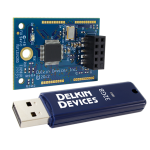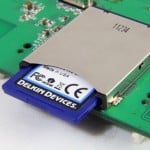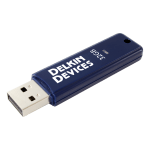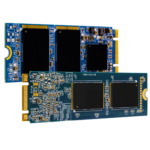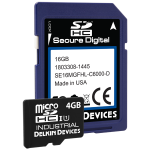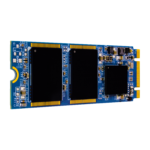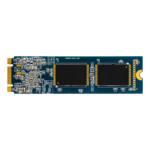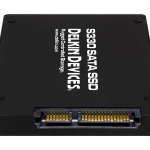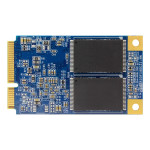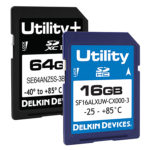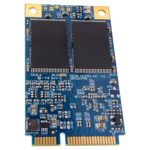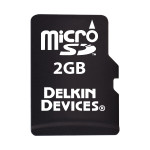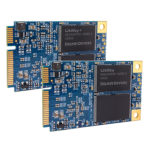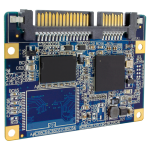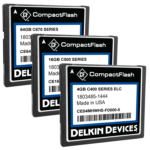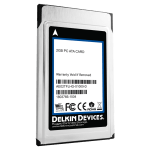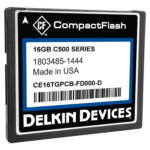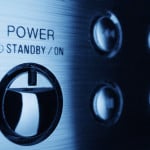Delkin Blog
Are You in the Market for a 512MB USB Flash Drive?
USB flash drives are familiar storage devices in both the consumer and industrial markets. There are many reasons for their enduring popularity, including their ease of use, wide-ranging compatibility, and variety of storage capacity options. In the industrial storage marketplace, industrial grade USB flash drives are engineered to work in exacting conditions, where temperature, vibration, and shock are unpredictable and where storage has to be fail-safe. The 512MB USB flash drive size is one of the most popular versions...
Read More
Read More
Industrial Flash Drives – Framework & Composition
Introduction Industrial Flash drives, no matter the form factor, are more complex than meets the casual eye. A Flash drive consists of two major parts. One part is, of course the Flash chips, and the other part is a highly integrated controller chip, or CPU. This article will focus first on basic Flash architecture, operation and how it can be configured in different ways with the CPU to achieve different performance speed goals. Flash Storage Data Structure All data whether it is an...
Read More
Read More
Storage Insights #3 -Technical Guide for CompactFlash (CF) and Secure Digital (SD) Cards
Click below to read the new Delkin Storage Insights post on the element14 Community Embedded Blog: Storage Insights #3 -Technical Guide for CompactFlash (CF) and Secure Digital (SD) Cards ...
Read More
Read More
Technical Success Story: Life Cycle Management with SMART Technology
The technology that makes flash storage so fast and reliable also limits the amount of time it can be used effectively, as there are a limited number of reads and writes a flash storage card can complete. At Delkin, extending the lifespan of flash storage product is a core part of every product we design, as we understand that our customers need the longest life possible out of their industrial storage solutions, and SMART technology can help. Because all...
Read More
Read More
Why Does USB Flash Drive Temperature Range Matter?
There are many different factors that differentiate commercial flash storage from industrial flash storage. The operating temperature range is one of those factors. For many industrial users, temperature range is a primary concern when choosing a flash storage device, since many industrial users have applications that must work in conditions with extreme temperatures or in which temperature fluctuations are common. When it comes to portable USB storage, it may seem like temperature range is less of a concern, since the...
Read More
Read More
Examining the Advantages of SLC SD Cards
Industrial systems rely on flash memory for critical storage. SLC SD cards have long been one of the most widely used technologies for embedded storage in industrial environments, and the demand for high-quality, SLC-based flash storage is only increasing as flash technology itself is changing. The appearance of MLC and TLC SD cards has created welcome changes in the consumer market that are not as advantageous for industrial grade products, and some industrial host device engineers and designers have...
Read More
Read More
SLC NAND vs. MLC NAND
If you are exploring your options for embedded flash storage, two contenders are likely to be on your list: SLC NAND and MLC NAND. Both of these forms of NAND flash storage are popular and reliable, and each one has its most appropriate uses. The trick is not using MLC NAND when you really need SLC, or paying for SLC when you could get by with MLC. Which NAND flash storage technology is right for your application? This comparison...
Read More
Read More
FAQs about BOM Control
BOM control is a critical factor for industrial embedded application customers. It allows both OEMs and engineers to better manage parts changes and reduces the risk of in-the-field failures that could have drastic effects on transportation, aviation, healthcare, and other critical industries. One of the key reasons that industrial grade flash storage is used in these kinds of applications is the advantages that BOM control provides. Why does BOM control matter so much? Here are the answers to some...
Read More
Read More
A Closer Look at Industrial Grade MicroSD
For powerful storage that fits into a small space, microSD is an enduringly popular choice. Because it is available in a range of storage capacities and is highly adaptable to a wide range of applications, this form of flash storage can be found in an enormous range of host devices. MicroSD memory cards are available in MLC and SLC formats, but for industrial grade devices that operate in extreme conditions, choosing a matching industrial grade microSD card is important....
Read More
Read More
Answering Questions about SLC CompactFlash
SLC Compact Flash—known more commonly as CompactFlash or CF—is one of the most reliable and most popular forms of storage on the market. In SLC format, CF memory cards are capable of supporting host devices in industrial environments without any kind of loss of function. For engineers and designers looking for a failsafe storage solution for devices in high-stress environments dealing with mission-critical data, it’s hard to find a better solution than CF memory cards. If you’re considering SLC...
Read More
Read More
Recent NAND Trends (And Why Reliability Is So Crucial)
The year 1987 was an exciting one for tech professionals. It marked the introduction of NAND flash, which made its debut at the IEEE International Electron Devices Meeting in San Francisco. Since that time, innovations in embedded designs and NAND trends have taken off. One of the top items on every developer’s wish list was to increase the storage capacity while keeping the price point on a downward trend. This begs the question: Has reliability been jeopardized in the...
Read More
Read More
What You Need to Know about Industrial CF Card 4GB Products
Industrial CompactFlash—also called CF—is an enormously popular form of flash storage for devices that are used in exacting conditions with mission-critical data. An industrial CF card 4GB storage capacity can be used in an array of products and devices, thanks to the reliability of industrial grade flash memory and constant uptime. The 4GB size is ideal for industrial products with moderate storage needs. Here is a closer look. CF Cards CF cards are one of the most popular flash storage formats...
Read More
Read More
Comparing 2D NAND vs. 3D NAND SSD
Flash-based SSDs, or solid state drives, were invented in the 1980s, so it is not surprising that the technology has progressed significantly since then. The main drive in improving SSDs has always been scaling, focusing on fitting more data into the same sized space. For many years, this effort was limited by the fact that NAND flash was planar. In other words, 2D NAND flash was the only available technology, thus creating an upper limit for the capacity of...
Read More
Read More
What Is 3D NAND Flash?
Most NAND flash drives are designed with planar NAND technology—in other words, the cells are arranged in a 2D format. This design is effective, but it has some limitations and challenges. The introduction of 3D NAND flash changes that. 3D NAND flash can be used in both commercial and industrial applications in the same way that planar NAND flash is, often with some advantages. As with all forms of NAND flash, 3D NAND flash offers lower latency rates and...
Read More
Read More
Choosing a High-Reliability USB Flash Drive
Sometimes, the most familiar solution is the best one. That is often the case with USB flash drives. For external storage, USB flash drives may be the most recognizable option on the market for everyone from novice, casual users to industrial clients with high-grade storage needs. When it comes to those industrial clients, nothing less than the highest possible level of security for data will do. For these needs, high-reliability USB flash drives are available. A high-reliability flash drive...
Read More
Read More
Using Industrial CF for Control Systems & Automation Applications
In today’s manufacturing facilities, ever increasing levels of automation are being implemented into control systems. As such, the demand for flash storage for machine control, process monitoring, and programming updates has never been higher. Because of the demands of the operating conditions in most manufacturing facilities, embedded memory solutions must be rugged, industrial grade devices that won’t fail in high-stress situations. Because of these operating conditions, it is not surprising that developers in the controls/automation industry are turning to industrial...
Read More
Read More
What to Do When an SD Card Is Write-Protected
When SD cards are write-protected, you will not be able to save the data on it that you need. Many people are surprised when they get a write-protected message when trying to save files to their SD cards, but fortunately, the fix is simple and fast to complete. Write-protection is an important feature that keeps your files safe when it is used appropriately, and it offers another level of data protection that can be especially valuable for industrial applications...
Read More
Read More
Flash Drive Definition Basics
Flash drive users vary widely, from casual computer users to professionals performing highly technical work with industrial applications. They provide a high-capacity, portable storage solution that’s ideal for a variety of uses. Despite the popularity of these storage devices, many people are unaware of the exact flash drive definition, even if they use this type of device on a regular basis. What exactly is a flash drive? Here is what you need to know. Flash Drive Definition A flash drive is...
Read More
Read More
How Long Do SSDs Last?
SSDs—or solid state drives—have many advantages over hard disk drives (HDDs). Despite the advantages, many people were slow to adopt SSDs because of concerns over their lifespan, and a few nagging doubts remain in the minds of some developers about the potential for lost data caused by an SSD failure. In reality, the stories of SSD failures and short lifespans are greatly exaggerated. SSDs are reliable and widely used in a variety of sensitive applications, ranging from healthcare to...
Read More
Read More
Understanding SSD Architecture
Solid state drives, or SSDs, were considered a revolutionary advance in data storage when they were introduced to the market, and they continue to be the preferred drive for the vast majority of consumer and industrial-grade Flash storage products. Because SSDs don’t contain moving parts, they are better equipped than hard disk drives, or HDDs, at operating in rugged conditions, and they also function faster and without the noise associated with HDDs. One of the key components in SSD...
Read More
Read More
Industrial microSD Card Connectors
In applications using an SD interface, it is important for the interface and connectors to deliver the right level of ruggedness and reliability for the way the host device will be used. Many SD-compatible flash interfaces are designed to be used in consumer products, and although these are well suited to those kinds of devices, they are generally not reliable enough for industrial applications. Instead, industrial applications that use the SD interface must be designed with industrial-grade card connectors....
Read More
Read More
SSD Components: Focus on NAND Flash Die
Solid state drives, or SSDs, use NAND flash to store critical data. NAND flash memory is a nonvolatile form of storage, meaning it does not require power in order to store data. This form of memory is critical for SSDs to compete with hard disk drives, or HDDs, and the magnetic storage that they contain. Within the architecture of SSDs, there can be multiple NAND flash chips—also referred to as NAND flash die. The number of die used in...
Read More
Read More
Solid State Drive Technology FAQs
Solid state drives are the foundation upon which a huge array of modern technology exists. Everything from digital cameras to gaming devices rely on solid state drives—also known as SSDs—for memory. They provide reliable performance, even in less than ideal operating conditions, which is why so many engineers and developers depend on them in their designs. What are SSDs and how do they work? Here are the answers to frequently asked questions about solid state drive technology. What exactly is...
Read More
Read More
SD Card Pinout Basics
The serial interface of SD cards has made them hugely popular in both consumer and industrial devices for OEMs. The SD Card Association tightly controls the specifications of SD cards, including the SD card pinout, so there are universal standards for everything from physical interfaces to command protocols that make integration seamless and easy. SD cards are designed to meet the needs of both consumer and industrial markets and their differing budgets. Most consumer devices rely on MLC flash...
Read More
Read More
SSD Wear Leveling Tests
Solid state drives, or SSDs, have many advantages over hard disk drives (HDDs). Since SSDs don’t have moving parts, they don’t fall victim to the mechanical failures that can plague HDDs. They never develop magnetic problems on the platters, since there are no platters to spin. Of course, there is a trade off. SSDs have a finite number of writes that they can perform depending on the kind of flash memory that they use for storage. Wear leveling is...
Read More
Read More
A Closer Look at Read Disturb Errors
When NAND flash memory is used only for read operations, many designers believe that they do not have to worry about product lifespan, since no writing is occurring. In reality, even read operations can eventually wear the flash memory out, as repeated read operations can lead to inadvertent reprogramming and damage caused by cross-coupling noise. When these issues occur, they are called read disturb errors. Fortunately, industrial-grade NAND flash memory typically comes with read leveling and ECC integrated to...
Read More
Read More
Flash Storage Life Cycle & Component Volatility Management
Industrial Flash Storage for Leading-Edge Applications The typical Flash user is one that utilizes various form factors for images, temporary portable storage, or high-end, high-speed, high-capacity drives for a compute intensive application, often called the ‘leading-edge’. This arena changes very rapidly with a life span of sometimes only several months before a product may be declared obsolete or outdated. Delkin Devices works closely with each industrial OEM and customer to ensure the right industrial Flash storage solution is chosen to...
Read More
Read More
What Is Flash Based SSD?
A Flash based SSD is a solid state drive that uses NAND flash memory. NAND flash is a nonvolatile form of storage that is critical for allowing SSDs to match the capacity and performance of hard disk drives, or HDDs. With NAND flash memory in play, SSDs have trumped HDDs as the preferred drive style for many users, since it doesn’t have the potential for breakdowns that are commonly caused by the moving parts in HDDs. Here is a...
Read More
Read More
Answers to Questions About mSATA Speed
Flash storage that uses the SATA interface is popular in a range of different devices and applications. It has virtually replaced IDE/PATA interfaces that once ruled the market. For applications and devices that want to use the SATA interface but need a small form factor, mSATA is the solution. As with any kind of flash memory, speed is likely to be a top concern on the minds of engineers when selecting mSATA for storage. Here are the answers to...
Read More
Read More
Rugged SD Cards 101
SD cards are a widely used form of flash memory in consumer, commercial, and industrial devices. Rugged SD cards are made specifically for industrial users who need memory that won’t quit in extreme conditions with fluctuating temperatures, shock, and vibration. SD cards have been around since 1999, and one of the reasons they have lasted in the fast-paced world of technology is that they offer superior reliability and simple product integration. Here is what you need to know. SD cards...
Read More
Read More
DVT and ORT- Exploring Delkin’s Commitment to Product Testing
Testing is a critical part of creating robust embedded storage devices. It allows problems to be identified and corrected before they ever make their way into an application and cause failures. At Delkin, we’re continually investing in new and better ways to test our products and deliver consistently high-quality industrial storage options. This includes investing in DVT and ORT in-house. DVT and ORT Delkin continuously invests in DVT—Design Verification Testing—and ORT—Ongoing Reliability Testing. We do these tests in-house using advanced testing...
Read More
Read More
Technical Success Stories:Rugged Environmental Requirement Testing
CompactFlash (CF) has been a key embeddable storage form factor for over 20 years, thanks to its basic connector design that mimics a hard disk drive, or HDD. It is both rugged and simple, making it a widely used storage form factor. When CF was initially introduced to the market in 1994, the cards used single-level cell, or SLC flash, and were incorporated into thousands of applications. CF cards have four physical chips, and the memory itself is cased...
Read More
Read More
Technical Features of 32GB mSATA
mSATA offers the reliability of the popular SATA design in a form factor that’s appropriate for small devices. When mSATA was introduced, it was a computer-centric form of flash memory, intended for use in notebook computers and other thin devices that required powerful storage in a small form factor. Eventually, the low weight and small size of mSATA made it a desirable option for industrial devices as well as consumer products as a boot drive or for data storage....
Read More
Read More
Facts about OEM Micro SD Cards
An OEM micro SD card—also called microSD—can provide high-endurance storage for a wide range of applications. If your application requires reliable storage that uses a minimal amount of power and has the ability to be integrated into multiple form factors, an OEM microSD card could be the right answer for you. These facts will help you determine if these memory cards are the best option for your OEM design. microSD cards have been on the market since 1999. Consumer SD cards,...
Read More
Read More
Using Embedded Flash Storage in the Industrial Internet of Things
The internet of things, or IoT, is a complex network of connections between different devices with embedded features. It is changing the landscape of nearly every aspect of life, and as an increasing number of devices achieve this kind of connectivity, the power and usefulness of technology will increase as well. The industrial internet of things, or IIoT, refers to interconnectivity and automation between industrial devices. IIoT encompasses many different industries and needs, but in all of them, storage is...
Read More
Read More
SD Card Interface FAQs and Answers
The Secure Digital Card Association established the specifications required for all Secure Digital (SD) memory cards, including the command protocols and the physical SD card interface. This simplifies the application development process for engineers, as the strict guidelines eliminate unexpected deviations and support predictable, reliable operations. Here is a look at the answers to a few common questions about the SD card interface. How can I access the official SD card interface specifications? The Secure Digital Association maintains tight control over...
Read More
Read More
A Look at mSATA Speed Capabilities
Certain applications require the performance of a SATA solid state drive (SSD), but with a smaller form factor. For OEMs and developers, the solution is often to use a mini SATA, or mSATA, drive. The mSATA speed and data storage capacity are robust enough to handle applications in any industry—from healthcare and aerospace to gaming and digital signage. In addition, mSATA technology eliminates the need for a 2.5-inch housing, which makes the form factor slim and versatile. The Basics of...
Read More
Read More
NAND vs. NVMe: What You Need to Know
NAND vs. NVMe- The ever-expanding need for data storage capacity and speed in both commercial and industrial applications has caused a growing list of options for memory. For engineers and OEMs, keeping up with the advances and determining what fits best in their applications is an ongoing process. A subject that frequently comes up is NAND vs. NVMe—what are these two technologies and how do they compare to each other? As it turns out, NAND and NVMe aren’t in...
Read More
Read More
Facts about the SMART Industrial Grade Compact Flash CF Card
Compact Flash has been a leader in flash storage since 1994, when it was first introduced to the market. Since then, it has become a highly sought after and widely used form of flash memory in both consumer and industrial grade applications. SMART industrial grade compact flash CF cards combine the reliability of industrial flash storage with self-monitoring SMART technology to add an extra layer of protection for industrial operations. These popular memory cards are compatible with a wide...
Read More
Read More
What Is a PCMCIA Memory Card?
PCMCIA memory cards have been on the market for over 25 years, but there is still a demand for this legacy product. These memory cards are appropriate for both consumer and industrial grade applications, with industrial designs featuring all of the standards you would expect from a rugged memory solution. In fact, PCMCIA memory cards are so reliable that they are frequently found in military applications, where data loss cannot be tolerated. With capacities of up to 4GB and...
Read More
Read More
JEDEC MO-300 and mSATA Designs
mSATA is a small form factor solid state drive, or SSD, that is used for flash memory when embedded applications require mountable storage. mSATA can be embedded in OEM applications via screws and a card edge connector. Available in both industrial grade versions that use SLC storage and commercial grade incarnations with MLC flash, mSATA flash storage is designed to meet the specifications for JEDEC MO-300 for compatibility. JEDEC MO-300 JEDEC is an international organization with over 300 members that works...
Read More
Read More
Comparing SLC vs. MLC vs. TLC
When choosing flash memory, one of the choices you will need to make is between SLC vs. MLC vs. TLC flash. Although these grades of NAND flash storage work on the same principles, the way they save data is different, which makes each one best suited for different kinds of applications. Here is a look at how these flash memory grades differ and which applications each will perform best. SLC Single-level cell flash, or SLC, is a type of NAND flash...
Read More
Read More
A Look at the Benefits of MO-300 Industrial Storage
MO-300 industrial flash storage—more commonly known as mSATA—is a popular option in applications that require powerful storage in a small space. MO-300 industrial storage is specifically made for applications that have unique operating demands, such as the need to work in rugged conditions or handle sensitive data. The fact that mSATA brings the ever-popular SATA interface into a smaller form factor makes it all the more appealing for many developers. In industrial applications, you can find mSATA doing everything...
Read More
Read More
M.2 SATA vs. mSATA
If you are looking for SATA-based storage for a small device or application, then M.2 SATA and mSATA are two options that you may consider. Although they have similarities, they are not interchangeable, and one is not better than the other in every case. For engineers, understanding M.2 SATA vs. mSATA and weighing up how they can work for a specific design is the key to making the right choice. Here is a closer look at how these two...
Read More
Read More
Compact Flash Memory Card 101
Compact Flash memory card designs are available in a wide range of formats and capacities, with both SLC and MLC flash memory options. Consumers are generally most familiar with Compact Flash storage in the form of camera memory cards, but it can also be used in industrial applications that require increased ruggedness and greater read and write operating speeds. Compact Flash Memory Card Designs Compact Flash memory cards, or CF cards, are used for embedded applications as both boot drives and...
Read More
Read More
Reducing Power Fail Issues in Industrial Flash Memory
As embedded applications increasingly rely on solid state drives rather than traditional hard disc drives, the need to manage power fail issues has become central to ensuring data integrity. Delkin Devices designs solid state drives, or SSDs, that incorporate multiple levels of data protection should a power fail event happen, alongside the other features you expect from Delkin embedded applications, including small footprints, reduced power consumption, increased reliability, and high-level performance. Power Fails in Flash-Based SSDs Power fails that affect flash...
Read More
Read More
Facts about Industrial USB
Industrial USB offers the convenience of portable storage with the reliability, capacity, and ruggedness of industrial flash memory. Industrial USB devices are used across a wide range of industries, from the military to aviation and beyond, thanks to the data protection and functionality that they offer. Industrial USB Technical Specifications Industrial USB flash storage is designed to work in rugged environments without any loss of function or capacity. Here is a look at what to expect from an industrial USB:Operating temperature:...
Read More
Read More
FAQs about Flash Storage Devices
Flash storage devices are a key component in many commercial and industrial applications. There are multiple flash storage devices available for easy integration into a wide range of product designs. Questions often arise as engineers consider flash storage device options. Here are answers to some of the most common queries. What exactly is flash storage? Flash storage devices are an alternative to hard drives for storing data. With flash storage devices, data is stored in memory cells. Flash memory has very...
Read More
Read More
The Effect Of Data Write Size and Patterns on Solid State Drive Performance
General This article will describe the effect of writing small and large data clusters, randomly and sequentially to a Sold State Drive (SSD). Mechanical Vs. Solid State Disk Drives Spinning mechanical disk drives have one big advantage. They are virtually unaffected by the data transfer size or mode on writes. This is because of the nature of the media. It can be overwritten without any intervening erase. The spots on the media are re-magnetized. Convenient and fast. Not so with Solid State Media....
Read More
Read More
What Are My Options for Industrial Flash Storage Customization?
When it comes to industrial flash storage, one-size-fits-all solutions just don’t work. Every application has its own set of unique needs that have to be met for storage to work seamlessly and prevent operating issues in the field. Delkin understands the need for industrial flash storage customization and works closely with engineers and designers on their industrial OEM needs. In addition to a wide range of industrial flash storage customization options, Delkin will deliver the specific storage you need...
Read More
Read More
 Login
Login Register
Register


